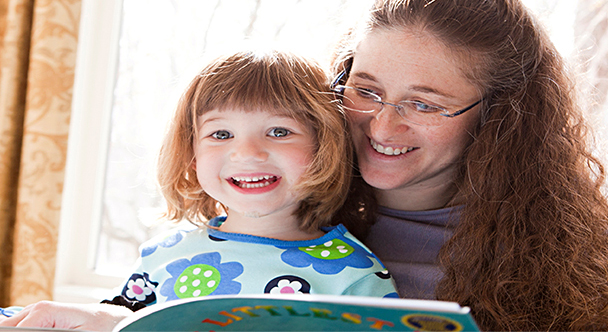Storytelling

Turning to Spirituality Series
Jewish Family Education with Candace R. Kwiatek, The Dayton Jewish Observer
Human beings are hardwired to recognize and tell stories, a fact first demonstrated scientifically in a notable 1944 study, An Experimental Study of Apparent Behavior by Fritz Heider and Marianne Simmel.
Participants were shown a short film of two triangles and a circle moving around a stationary rectangle with a door-like opening. However, instead of seeing animated geometric shapes, all but one of the test subjects created elaborate narratives, complete with motives and emotions, about the two-dimensional figures and their movements.
In his book, The Art of Immersion: Why Do We Tell Stories? author Frank Rose explains, “Just as the brain detects patterns in the visual forms of nature — a face, a figure, a flower — and in sound, so too it detects patterns in information.”
By identifying patterns, we are able to make sense of the world.

Stories are also universally recognizable patterns: the quest, overcoming the monster, rags to riches, struggling with God. They help us make sense of reality in a unique manner, allowing us to recognize and express complex ideas and dimensions of the world that we can’t entirely grasp or explain.
Stories are the most effective medium for exploring notions such as virtue, emotions, culture, power, good and evil, extraordinary events, life’s purpose, and the meaning of being human.
Such notions that aren’t “objectively real” become tangible in the framework of a story.
Judaism is a civilization built upon stories and a storytelling tradition that has continued from biblical times to the present.
Every year we reread the saga of our founders in the Torah, retell the story of the Exodus at the Passover Seder, and offer a lively rendition of Esther’s story on Purim.
Rabbinic storytelling, midrash, has continued unabated for more than 2,000 years, and the prophet Elijah has been featured in Jewish legends for just as long.
Today, we see a revival of the moral and spiritual storyteller known as the maggid, and now the maggida, whose roots can be traced back through medieval Europe to the early centuries of the Common Era. At Judaism’s core are its sacred stories.
For many Jewish families, sacred stories are a natural part of life. But what if you’re among the spiritually confused, apathetic, or nonbelievers?
How can such tales speak to you or to your children? “How do you support children’s spirituality when you yourself aren’t sure about belief…or when anything that smells like religion makes you squirm?” Lisa Miller asks in her New York Magazine essay, Why Kids Need Spirituality. Are sacred stories even necessary?
According to Columbia University Psychologist Lisa Miller (no relation), author of The Spiritual Child, the answer is a resounding yes.
Scientific research consistently demonstrates strong links between an ongoing positive sense of spirituality and superior physical, mental, and emotional health; brain function; human relationships; and professional accomplishments.
“In the entire realm of human experience,” Miller writes, “there is no single factor that will protect your adolescent like a personal sense of spirituality…our children need us to support their quest for a spiritually grounded life at every age.”
The good news is that spirituality occurs naturally in children, as long as it isn’t quashed with cynicism, anxiety, or impatience, New York Magazine writer Miller notes.
Even the most disbelieving parent can help build spiritual children simply by being available and interested, a role she calls “the spiritual ambassador.”
It’s not about having all the answers, but rather being a role model who is open to wondering, making discoveries, finding personal connections, and sometimes accepting a bit of mystery. And sacred stories of all kinds are the ideal place to start.
The magic of sacred stories is that they can’t be worn out or used up; there is always something waiting to be discovered.
And discovery is the key. Meaning that engages the mind, heart, and spirit is generated from the interplay between life experience and the sacred story; spirituality arises from participation and personal discovery.
Rabbi Dr. Michael Shire describes one method of inviting participation in sacred stories that, while it can’t be fully replicated at home, offers an excellent pattern to follow: Torah Godly Play. It emphasizes listening to the story followed by a series of four wondering questions, none of which has a scripted “right” answer.
Each question is followed by unhurried time for the child to formulate a personal response. Feeling: “I wonder what part of this story you like best?” Evaluating: “I wonder what part of the story is the most important?” Involving: “I wonder where you are in the story? I wonder what part is about you?” Thinking: “I wonder if there is any part of the story we can leave out and still have all the story we need?”
Participation in sacred stories through wondering isn’t just for children; you may want to try it yourself.
Story is “a thing that does,” not just “a thing that is,” scholar Brian Boyd concludes.
Because we are wired to recognize their patterns, stories help us make sense of the world around us.
The additional purpose of sacred stories is to help us recognize our spiritual connection to the world. To be fully human, we must engage with both.
Literature to share
The Chameleon that Saved Noah’s Ark by Yael Molchadsky. Vibrant, colorful, and simply told, this children’s tale is the “inside” story of Noah’s Ark. It’s mealtime and no one in Noah’s family can figure out what the chameleons like to eat. Great messages, yummy illustrations, and a totally enchanting animal hero — perfect for the start of the New Year.
What Will They Say About You When You Are Gone? Creating a Life of Legacy by Rabbi Daniel Cohen. The starting point for a positive life legacy is the question, “How do you want to be remembered?” according to the author. He then identifies seven principles for reverse-engineering your life. Through a seamless series of delightful anecdotes and quotes, Cohen offers prompts for reflection, exercises to practice, and strategies to explore to help you discover who you are and how to become what you want to be. Informational and inspirational, this is an enjoyable, worthwhile read.
To read the complete September 2017 Dayton Jewish Observer, click here.


